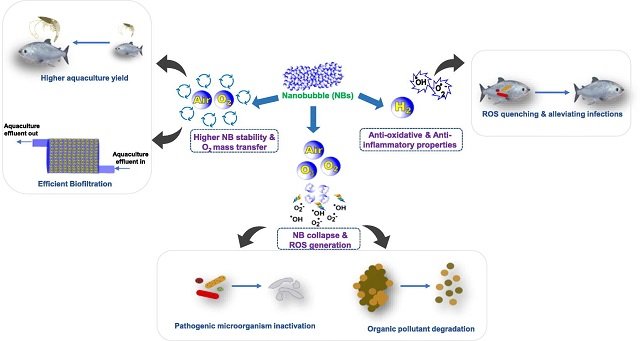
The increasing demand for seafood is pushing the aquaculture industry to intensify production; in this context, innovation is needed. The goal? Sustainable practices that increase yields without harming the environment or compromising animal health. A new and exciting technology emerging as a turning point is nanobubbles (NB).
A team of researchers from the University of Maine (USA) and Arizona State University (USA) published a scientific review examining the use of nanobubble technology in aquaculture systems for aeration, inactivation of harmful microorganisms, and to reduce oxidative stress and improve animal health.
What Are Nanobubbles?
Nanotechnology, the science of manipulating materials at the atomic and molecular level, is emerging as a turning point in aquaculture to enhance production, ensure disease protection, and enable water reuse in closed-loop systems.
Among emerging nanotechnologies, nanobubbles (NB), tiny gas-filled bubbles with unique properties, could impact the aquaculture industry by increasing crop yields, improving animal health, and providing cleaner water.
NBs are gas-filled cavities less than 1 micrometer in size, much smaller than macrobubbles (diameter ∼ 100-2000 μm) and microbubbles (diameter ∼ 1-100 μm). Some of the main characteristics of nanobubbles are:
- Long Lifespan: Unlike larger bubbles that quickly rise to the surface and release gas, NBs can remain suspended for days or even months.
- Efficient Gas Delivery: NBs excel at gas transfer to water, making them ideal for applications requiring oxygenation or other gases.
- Unique Properties: NBs can even produce hydroxyl radicals, potentially useful for disinfection.
How Can NBs Benefit Aquaculture?
Aquaculturists need to intensify their crops and traditionally resort to aeration to increase stocking densities. In this regard, nanobubbles hold immense promise for revolutionizing aquaculture practices in three key areas:
Enhanced Aeration
- NBs can deliver oxygen more effectively to fish and shrimp, leading to:
- Higher harvest yields and growth rates.
- Reduced oxygen consumption.
- Improved overall health.
Wastewater Treatment
- NBs can help break down pollutants in aquaculture wastewater, contributing to:
- Cleaner water systems.
- Reduced environmental impact.
Disease Control
- The potential ability of NBs to inactivate harmful bacteria and viruses could result in:
- Improved fish survival rates.
- Increased disease resistance.
Additionally, research has shown that nanobubbles positively impact the functioning of biofilters used in recirculating aquaculture systems and in the cultivation of microalgae.
The Need for Further Research
NB technology is still in its early stages, and more research is needed to ensure its safe and effective implementation in aquaculture. Key areas of focus include:
Stay Always Informed
Join our communities to instantly receive the most important news, reports, and analysis from the aquaculture industry.
- Comparative Studies: How do NBs compare with traditional aeration methods in terms of effectiveness and cost?
- Health and Safety: Are there any potential risks associated with the use of NBs in aquaculture? Optimization of NB application is needed to minimize risks such as oxygen supersaturation.
- Economic Viability: Will the long-term benefits outweigh the initial investment and maintenance costs?
Contact
Onur G. Apul
5711 Boardman Hall, Room 306, Department of Civil and Environmental Engineering, University of Maine
Orono, ME 04469, United States.
Email: onur.apul@maine.edu
Reference
Yaparatne, S., Morón-López, J., Bouchard, D., Garcia-Segura, S., & Apul, O. G. (2024). Nanobubble applications in aquaculture industry for improving harvest yield, wastewater treatment, and disease control. Science of The Total Environment, 931, 172687. https://doi.org/10.1016/j.scitotenv.2024.172687
Editor at the digital magazine AquaHoy. He holds a degree in Aquaculture Biology from the National University of Santa (UNS) and a Master’s degree in Science and Innovation Management from the Polytechnic University of Valencia, with postgraduate diplomas in Business Innovation and Innovation Management. He possesses extensive experience in the aquaculture and fisheries sector, having led the Fisheries Innovation Unit of the National Program for Innovation in Fisheries and Aquaculture (PNIPA). He has served as a senior consultant in technology watch, an innovation project formulator and advisor, and a lecturer at UNS. He is a member of the Peruvian College of Biologists and was recognized by the World Aquaculture Society (WAS) in 2016 for his contribution to aquaculture.



